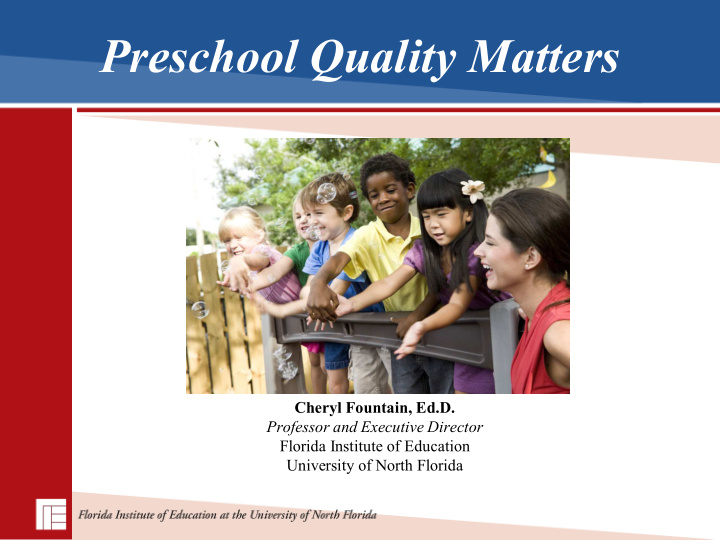



Preschool Quality Matters Cheryl Fountain, Ed.D. Professor and Executive Director Florida Institute of Education University of North Florida
Why Preschool Quality Matters Continued prosperity depends on a well-educated workforce and general public • Today’s children will become tomorrow’s citizens, workers, and parents • Brains are built over time and the quality of early experiences creates the foundation – either strong or fragile – for lifelong learning
Learning Experiences Matter The quality of learning experiences in the preschool years greatly influences children’s neurological growth and development Newborn neural networks compared Newborn brain size proportionate to networks of a 6 year old. to 6 year old brain. Science of Early Childhood Development, National Scientific Council on the Developing Child, Center on the Developing Child, Harvard University, 2007
Readiness Matters Research documents “readiness gaps” between children of poverty and their more affluent peers Cognitive Development Gap Social Skills Gap Barnett, W. S. (2007). Original analysis of data from the US Department of Education, National Center for Educational Statistics, ECLS-K Base Year Data files and Electronic Codebook (2002)
Quality Preschool For All Children • Many vulnerable children attend the lowest quality early learning and care programs • Many children from middle income families also attend programs that are rated less than good quality • Many children who do not have access to high-quality early learning and care programs are retained or drop out of school Income Retention Dropout Lowest 20% 16.9% 10.7% 20-80% 10.6% 5.4% Highest 20% 3.9% 1.7% Source: US Department of Education, NCES. Dropout rates in the United States: 2001. Retention rates in the United States: 2004.
Early Learning and Care Matters • Participation in high-quality early learning services can help close the “readiness gaps” • The average quality of early learning and care is less than good • Low-quality early learning and care services have negative effects that persist from preschool to high school and beyond
Turning the Corner: High-Quality in Every Classroom Dimensions of Quality
The Classroom Environment Matters Structural Elements are Necessary but Insufficient • Physical facilities • Numbers of children in each class • Staff-to-child ratio • Qualifications of teachers and staff • Ongoing and intensive professional development for teachers and staff • Compensation • Rigorous standards • Administrative leadership and support • Links between what we know and what we do • Collaboration with families
Learning Opportunities Matter Opportunities Facilitate Children’s Learning • Stimulating and engaging learning experiences • Focus on early literacy • Use of a curriculum that is research-based and attends to children’s o Physical, o Cognitive, o Social-emotional, and o Language development • Regular use of children’s assessment results to guide instruction • Time for play and exploration • Learning experiences extend into the home and community
Adult-Child Interactions Matter and so do Child-Child Interactions • Frequent conversations among teachers and children, and among children and their peers, take place throughout the day • Spoken language is the primary medium through which teaching is conducted and through which young children demonstrate what they know • Children’s home language and culture are respected, appreciated, and incorporated into the curriculum • Children are respected, nurtured, challenged, and encouraged
Adult-Child Interactions: A Closer Look • At the broadest level, classroom interactions between teachers and children can be grouped into three domains: Emotional Support : Teacher’s ability to support children’s social and emotional functioning Classroom Organization: Teacher’s ability to use processes that promote children’s development of self-regulation and attention to learning Instructional Support: Teacher’s ability to implement curricula in ways that effectively support children’s cognitive and language development Emotional Support Classroom Organization Instructional Support Dimensions Dimensions Dimensions Positive Climate Behavior Management Concept Development Teacher Sensitivity Productivity Quality of Feedback Regard for Student Perspectives Instructional Learning Formats Language Modelling Mashburn, A., Pianta, R., Hamre, B., Downer, J., Barbarin, O., Bryant, D. Burchinal, M., Early, D. (2008). Measures of classroom quality in prekindergarten and children’s development of academic, language, and social skills. Child Development, 79 (3), 732–769
Impacts of High-Quality Early Learning and Care Services Educational Success and Adult Productivity • Increased achievement test scores • Increased high school graduation • Increased employment, earnings, and contribution to society • Decreased behavior problems, delinquency, and crime • Decreased welfare dependency • Decreased special education costs and grade repetition Costs to Government • Decreased schooling costs • Decreased social services costs • Decreased crime costs • Decreased health care costs (teen pregnancy and smoking) National Institute for Early Education Research, Benefits and Costs of Quality Early Education for All, October 2006
Conclusions Investing in young children is the RIGHT thing to do All children deserve the chance to grow into healthy, educated, and competent adults Investing in young children is also the SMART thing to do Investing in improving the quality of early learning and care experiences translates into considerable cost savings and efficiency gains for both children and society, now and in the future. The best time to start is today!
Recommend
More recommend